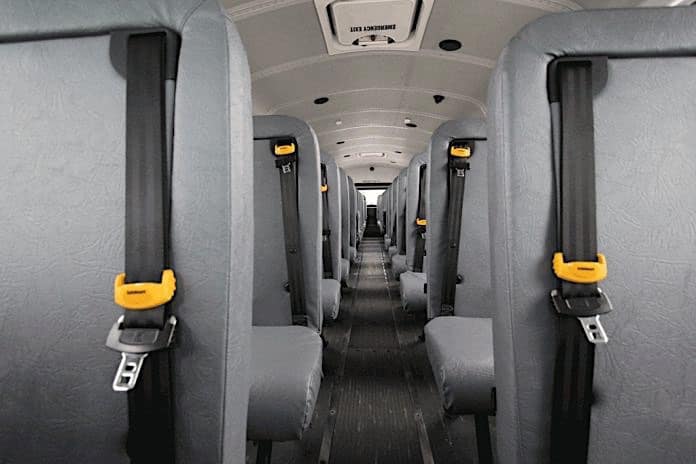While attending the 1986 dedication of a transit center in Eureka Springs, Arkansas, I overheard the mayor tell the governor that he had never voted for him in the past. But after all the work the governor’s office had done in getting the city the grant for the transit center, the mayor shared that he would vote for him in the next election.
Feigning shock, the then-Gov. Bill Clinton responded, “I’m a Baptist, Mr. Mayor, and we believe in deathbed conversion. I think I just heard your deathbed conversion!”
While not a deathbed conversion, I will admit that for the first 20 years of my career in the bus industry (transit, school, preschool and paratransit), I was a believer in the compartmentalization theory of school bus transportation as the sole necessary safety equipment students need inside the bus. Surrounded by foam pads in the “bigger” vehicle 90 percent of the time, traveling at usually lower speeds, I believed our children were protected in the event of a bus collision. Protected as well, if not better than they would be with lap/shoulder belts.
Being on scene and investigating 30 to 40 bus collisions a year—interviewing students, attendants and drivers, taking calls from passengers and parents who claim injury to themselves or their children, and working with insurance companies to settle those claims—I tended to believe that compartmentalization was adequate.
After all, in fleets under my control, we had never had a fatality inside the bus due to a collision. In fact, we never had a passenger spend even one night in a hospital due to injuries received while inside a bus.
But I now wholeheartedly think seatbelts should be in all school buses. So, what changed my mind?
As I would take school buses to pre-kindergarten centers and kindergarten recruitment signups to show the bus to the students and parents, without fail I would get the same question over and over: “Where are the seatbelts?”
I would give the standard compartmentalization speech, but each year it seemed I would see more quizzical looks from the parents. Then it hit me one day. These parents, born after 1980 like my daughter, have likely never ridden in a car without seatbelts. Unlike my generation, which had to be forced to wear them under threat of penalty from state laws, mandatory seatbelt usage is the norm for parents under the age of 45 (except those who live in New Hampshire, the last hold-out in not enforcing seatbelts for any passenger) and especially their children.
So, like all good Baby Boomers when we are stumped, I Googled the issue. I searched for news articles, position papers and scientific readings. Then, I YouTubed the information.
Suddenly, I realized seeing is believing.
Instead of concentrating on test dummies and actual footage of students flying around the school bus, and trying to cite flaws and place blame on the students for not being seated properly, I started looking at the videos differently. [I looked for] proof that seatbelts, while maybe not making a statistical difference in preventing school bus-related deaths (since the vast majority of those fatalities occur outside the bus in the “Danger Zone”), most certainly would help curb serious injuries in major crashes.
Even though we insured our buses through a shared-risk, self-insurance group and enjoyed state tort immunity from lawsuits exceeding our coverage limits, I was keenly aware of the number and cost of many passenger injuries that required medical treatment.
But still not convinced and living in one of the 45 states that don’t require lap/shoulder seatbelts on school buses, I looked deeply at the industry arguments against the occupant restraint systems. One by one, as I actually pondered each argument, I started seeing flaws in many of them. Let me share with you my reasoning for my newfound opinion.
Argument No. 1: The cost/benefit doesn’t make sense. Really? Whose benefit? Do you mean the parent who has lost a child? Or the bus driver that has to live with the memories of the accident? How about the children that witnessed their classmate dying in front of them? Even if only one life per decade, per state, is saved, that is 50 less dead children. That is two classrooms, 10 basketball teams, a whole marching band of children gone because we failed to spend $11 per year over the 15-year life of a 66-passenger bus (based on figures from the National Association for Pupil Transportation).
Argument No. 2: Most deaths occur outside the school bus, and seatbelts won’t help that. While true, death is not the only result of a school bus incident. Injuries suffered inside a school bus are costly and traumatic to children and parents. The average cost of a trip to the emergency room is $1,389, and add $1,000 if an ambulance is used (per the Health Care Cost Institute). And if medical flight services are called, as my family knows from personal experience, the cost increases by tens of thousands of dollars. Google “interior view of school bus crashes” and watch the videos. Then tell me seatbelts would not have prevented many injuries.
Argument No. 3: The bus (driver, company, school district, city, state) would be liable if a student rides unbuckled. Not if properly researched federal, state, local and school board laws and rules are adopted. Any major policy change requires thoughtful planning and research. Laws can be written in such a way to absolve bus operators, public and private, from liability. California has such laws that have influenced proper driver/student training and maintenance.
Argument No. 4: What if there is a rollover or fire, and students are knocked unconscious and can’t get out of the seatbelts? The percentage of rollover accidents is rare. The percentage of rollover accidents with fire is even less likely. Watch the videos of rollover accidents and tell me, which ones would have more people conscious to assist in evacuations? Ones with seatbelts or ones without?
The industry is coming around. I just wish it had happened earlier.

John Haynie is a 35-year veteran of the transportation industry. In 2015, he retired from the North Little Rock School District as director of transportation. He was a member of the Arkansas Association of Pupil Transportation, for which he served as host of the annual conference for four years. The association awarded him the President’s Star in 2014.

















